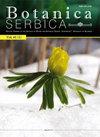Juniperus macrocarpa endophytes isolated on standard‐ and plant extract supplemented-culture media - and evaluation of their antimicrobial activity
IF 1.1
4区 生物学
Q4 PLANT SCIENCES
引用次数: 0
Abstract
This study aimed to investigate the endophytes of Juniperus macrocarpa collected from ?esme in ?zmir, Turkey, using a culture-dependent approach and to evaluate their antimicrobial activity for the first time. Since endophytes interact with phytochemicals of the host plant, in addition to the standard culture media, a J. macrocarpa extract supplemented culture media was also used for isolation to enhance the cultivability of the endophytes. Six bacteria out of twelve and three fungi out of seven were isolated from the plant extract supplemented culture media. The genotypic identification of the bacterial and fungal isolates was determined based on 16S rDNA and Internal Transcribed Spacer (ITS) sequence analysis, respectively. The genus Juniperus, which has ethnopharmacological uses, is rich in phytochemicals with multiple bioactivities. Since Juniperus spp. is listed as a priority natural habitat, it is necessary to find alternative resources that could replace the bioactive compounds of these plants. Endophytes of Juniperus spp. might be good candidates as antimicrobial producers. From this point of view, the antimicrobial activity of the crude fermentation liquid of the J. macrocarpa endophytes, and also aqueous and methanolic extracts of J. macrocarpa, were evaluated using a disc diffusion assay against a panel of test microorganisms, including antibiotic resistant ones. One fungus and seven bacteria showed remarkable antimicrobial activity against at least one test microorganism. These results indicated that some endophytes of J. macrocarpa had antimicrobial properties like their host plant and could substitute these plants as a source of antimicrobials.大刺柏内生菌在标准培养基和植物提取物培养基上的分离及抑菌活性评价
本研究采用培养依赖法对采自土耳其伊兹米尔的大杉木内生菌进行了研究,并首次对其抗菌活性进行了评价。由于内生菌与寄主植物的植物化学物质相互作用,在标准培养基的基础上,还采用江蓠提取物补充培养基进行分离,以提高内生菌的可培养性。从添加植物提取物的培养基中分离出12种细菌中的6种和7种真菌中的3种。采用16S rDNA和ITS序列分析对分离的细菌和真菌进行基因型鉴定。杜松属植物含有丰富的植物化学物质,具有多种生物活性,具有民族药理学意义。由于杜松被列为优先的自然栖息地,有必要寻找替代这些植物的生物活性化合物的替代资源。刺柏属内生菌可能是抗微生物菌的良好候选菌。从这个角度来看,利用圆盘扩散法对一组试验微生物(包括耐药微生物)评估了粗发酵液和粗内生菌的抑菌活性,以及粗内生菌的水提取物和甲醇提取物。1种真菌和7种细菌对至少一种微生物表现出显著的抑菌活性。这些结果表明,一些内生菌具有与寄主植物相似的抗菌特性,可以替代寄主植物作为抗菌药物的来源。
本文章由计算机程序翻译,如有差异,请以英文原文为准。
求助全文
约1分钟内获得全文
求助全文
来源期刊

Botanica Serbica
Agricultural and Biological Sciences-Plant Science
CiteScore
1.40
自引率
12.50%
发文量
17
审稿时长
34 weeks
期刊介绍:
Botanica Serbica publishes original research papers on all aspects of plant, fungal and microbial biology research including the disciplines of microbiology, mycology, lichenology, bryology, flora, vegetation, biogeography, systematics, taxonomy, plant biotechnology, plant cell biology, plant ecology, environmental plant biology, forestry, genomics, horticulture, limnology, metabolomics, molecular biology, proteomics, virology, plant conservation and protection, and wildlife and ecosystem management.
 求助内容:
求助内容: 应助结果提醒方式:
应助结果提醒方式:


